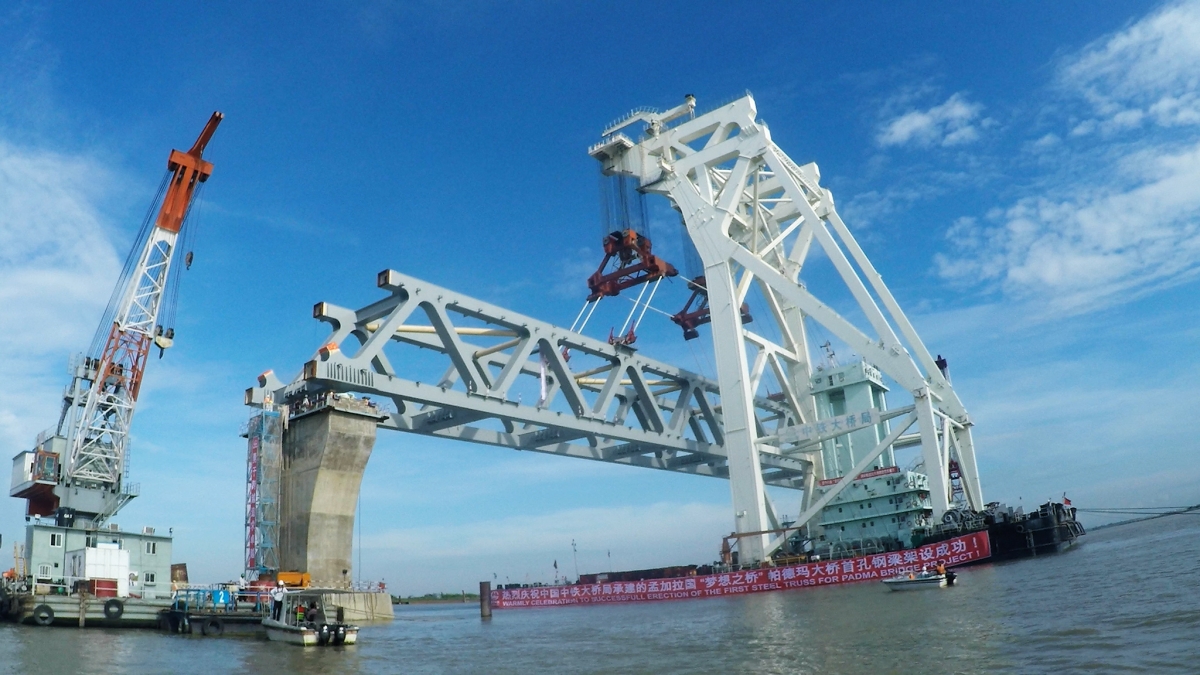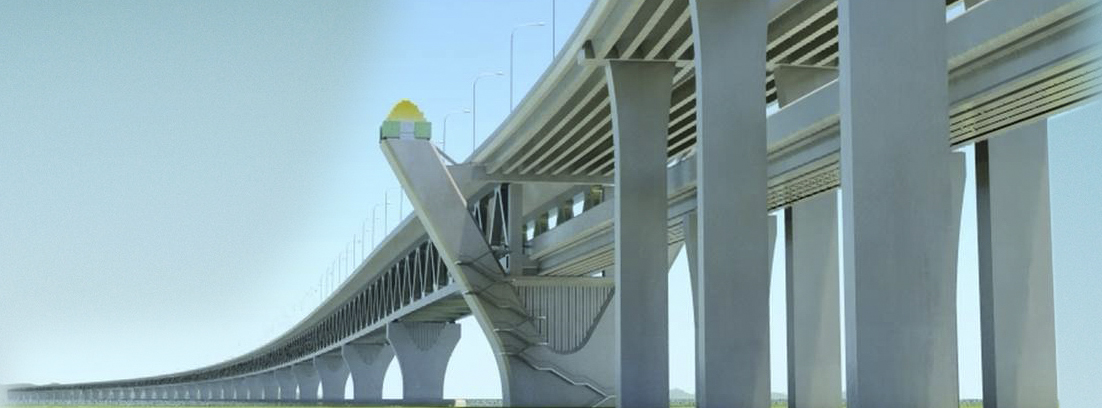The Padma Bridge: Promises and Challenges
Renowned economist Zahid Hussain gives a 360-degree view of the promises and challenges of the Padma Bridge, the dream project of the nation.

With the laying of the last span in December 2020, the completion of the 6.15 km Padma Bridge (PB) is insight. There are still some works to be done–road and railway slabs, installation of Super-T girder, pitch casting on the slab, lighting, lampposts, toll booths and so on.
Another year and a half may be needed to open the bridge to traffic, according to the Bangladesh Bridge Authority (BBA). The first span of the bridge was laid on September 30, 2016. Various obstacles and challenges had to be handled since then while installing all the spans in three years, two months, and 10 days.
We can only hope that the new deadline will be met, now that the technically most challenging part of the construction is done. The potential benefits from PB will not accrue until it is open for road and rail traffic.

Likely economic impact
The impact of PB can be divided into two phases—construction and operation.
The construction phase has already boosted production, employment, and income. One-third of the Tk +30,000 crore project is domestically sourced. Bangladeshi producers, local contractors, sub-contractors, and workers are working seamlessly with their foreign counterparts, led by the China Major Bridge Engineering Company, in river training, building the main bridge, and constructing approach roads.
The construction of 43 piers on the rivers and 76 on the shore sourced steel rods, cement, concrete, and sand from local companies who also provided most of the supplies to. China’s Synohydro Corporation in their Tk 9,000 crore river training work. Local enterprises participated in riverbed excavation, embankment development, dumping blocks, and providing geo-bags.
The impact during the construction phase is likely to pale in comparison with the impact induced by the operation of the bridge. Transport links people, connects local communities to the world, builds markets and facilitates trade.
The opening of the bridge to road and rail traffic will bring immediate benefits to the direct users. The distance from Dhaka to nearly all major destinations in the southwest region will be reduced by the equivalent of 100 kilometers or more, bringing tremendous savings in the time and costs of passenger and commodity movement, vehicle operation and maintenance costs, burning of fossil fuels.
It will immediately end the hassle of getting stuck at the ferry ghats for tens and thousands of passengers’ day in day out. Nature will be less able to disrupt transport connectivity with the southwest when the PB is open for use. Impacts such as the increase in production and income based on the improvement of accessibility will take time and depend on other conditions in the economy.
The social, economic, and industrial underdevelopment of the southwest zone, encompassing Bangladesh’s second major port, Mongla; its third main city, Khulna; and the inland port at Benapole, is due in part to difficult access across the Padma River to the rest of the country. Thus, the Southwest Region is expected to benefit most. By creating new business and job opportunities, an operational PB will change daily economic activities by integrating the Southwest with the Central Region where Dhaka is located. The Southwest Region will have a smooth and permanent all-weather road link over the Padma River to connect with the Dhaka city.
The reduction in cost of internal trade will spread to economic sectors all over the country, generating additional value added and creating new job opportunities through improved accessibility to and from other important cities and core facilities on the opposite sides of the Padma River.
The benefits such as savings in vehicle operating costs and travel time accruing from the PB are direct to the users. Impacts such as the increase in production and income based on the improvement of accessibility are “indirect or induced”. These result in additional demand and production in related economic sectors.
Early studies indicated that the bridge would increase the national annual GDP by 1.2 percentage points and the gross product in the southwest region by 35 percent compared to the “Without Bridge Case”. Despite cost escalation by over 3 times relative to the original estimate in 2007, the projected size of the benefits remains robust, according to most assessments. These impacts will take over 10 to 20 years after opening before becoming fully apparent.
The bridge will pave the way for making significant progress on the Sustainable Development Goals. The southwest region has one of the highest poverty rates. A major portion of direct benefits will go to the poor who constitute 55 percent of the passengers currently crossing Padma River by launch. The bridge will enable local people gain better access to healthcare facilities available in Dhaka. The economy of the char lands in the Padma River channel, based largely on agriculture, fishing and livestock-rearing, will gain from reduced erosion and vulnerability among people displaced by erosion.

Cross-border effects
Padma Bridge has implications for national and regional economic growth through promotion of international transport between surrounding countries. Bangladesh is geographically situated to provide international links to neighboring countries. The strategic location of the Bridge promises to contribute to the formation of a multi-modal international transport network for the Eastern Region of the Indian Subcontinent through strong links along the Asian Highway.
Transit land routes for India to its eastern states of Tripura, Manipur and Mizoram will become more efficient options as the PB becomes functional. Significant impacts are expected on international trade between neighboring countries such as India, Nepal, Bhutan, and Myanmar.
Unlike the impacts on the domestic economy, impacts on international traffic or cross-border traffic will not be automatically realized simply by opening of PB. There are many institutional and technical constraints on the expansion of international trade with surrounding countries such as inadequacies of bilateral transit agreements in ensuring smooth cross-border traffic.
It takes about 1 week or 10 days for crossing the border at Benapole Land Port, for example. These delays at the border will seriously negate the effects of PB. The improvements should include simplification of cross-border inspections and standardization of documents and the facilities in land ports to handle increased flow of trucks or cargos.
An early operationalization through expeditious signing of the Enabling MoU for Bangladesh, India and Nepal Motor Vehicles Agreement will help boost traffic over PB. Once the agreement comes into force it will save a lot of time in movement of goods between member nations with synergies resulting from the presence of the PB.
Regional organizations, such as SAARC (South Asian Association for Regional Cooperation) and BIMSTEC (Bay of Bengal Initiative for Multi-Sectoral Technical and Economic Cooperation) have an important role to play in the optimization of the cross-border effects of PB.
The toll policy
Well designed and implemented tolls contribute to making transport systems more efficient. Tolls help contain the negative impacts of road transport by incentivizing efficient use of vehicles. The increase in operational cost of vehicles impacts the efficiency of how trucks are loaded as pricing pressure decreases the likelihood of empty headings or suboptimal vehicle loads. On the other hand, it also adds to the financial cost of using the bridge.
There exists now the potential to build upon the existing toll policy in place for the Jamuna Bridge. BBA has formed a committee to work on a new toll policy. The toll at the bridge is usually determined by the Roads and Highways Department (RHD) at the same rate as collected on the ferry before the bridge is built. BBA last year suggested a toll rate for 15 years after the launch of the PB. A South Korean company may be appointed for maintenance and toll collection under government-to-government arrangement. The Korean company will use automatic toll collection system so that no vehicles must stop at the toll booths.
The tolls must be such as to induce sufficient traffic willing to pay a high enough toll to fully cover financing, construction, maintenance, and toll collection costs. Their political unpopularity often constrains the setting of tolls below the financially optimal levels. There have also been controversies over toll schedules that favor domestic residents over foreign users. The tolls on the highways on both sides of the PB will also matter in determining the traffic crossing the PB.

Unlocking the potential benefits
Supporting investments and policies are needed even before its scheduled completion in 2022 to fully realize the expected impacts. Construction and improvement of feeder road network and approach roads to connect the bridge with rural areas will be critical. Supportive institutional, legal, and regulatory governance, including establishing monitoring and evaluation frameworks, will be needed for actualizing the potentials of expanding cross-border trade. It is necessary to improve domestic laws and regulations related to transportation to be able to transit through the territory of Bangladesh.
The economy needs reliable infrastructure to connect supply chains and efficiently move goods and services within and across borders. PB promises to be a transformative example provided the other related choices respond to economic, demographic, fiscal, and environmental changes and help people, places and firms thrive and prosper.
To realize the benefits from the Trans-Padma Corridor, the BBA, Bangladesh Railway, and the Roads and Highways Division must upgrade its managements and financial conditions. Each of them could consider securitizing the tolls collected. The funds raised from securitization can be used for the development of roads and bridges under their jurisdictions.
Setting up effective maintenance systems and promoting private sector participation in roads are key to supporting reforms to improve transport system efficiency. The legislation and policy measures require fundamental changes to the roles of several concerned institutions. Longer than anticipated delays in implementing these reforms will add uncertainty to the realization of benefits from the PB.

